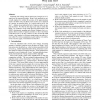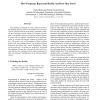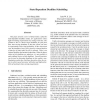2663 search results - page 4 / 533 » How to Choose a Timing Model |
FORTE
2004
13 years 9 months ago
2004
Passage time densities are useful performance measurements in stochastic systems. With them the modeller can extract probabilistic quality-of-service guarantees such as: the proba...
ICCAD
2008
IEEE
14 years 4 months ago
2008
IEEE
Statistical static timing analysis (SSTA) has emerged as an essential tool for nanoscale designs. Monte Carlo methods are universally employed to validate the accuracy of the appr...
WCRE
2006
IEEE
14 years 1 months ago
2006
IEEE
Programming is modeling the reality. Most of the times, the mapping between source code and the real world concepts is captured implicitly in the names of identifiers. Making the...
HRI
2009
ACM
14 years 2 months ago
2009
ACM
This paper proposes a model of approach behavior with which a robot can initiate conversation with people who are walking. We developed the model by learning from the failures in ...
RTSS
2002
IEEE
14 years 12 days ago
2002
IEEE
This paper presents a new workload model, called the state-dependent deadline model, for applications whose high-level timing requirements may change with time. The problem is how...



